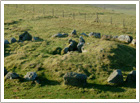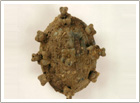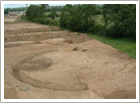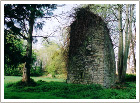Exciting Discoveries in Finglas
Viking find gets the kid glove treatment In archaeological circles, it doesn't get much better than this. Last Monday afternoon, a routine excavation on a site in North Dublin yielded what has become one of the rarest Viking finds in this country for more than 100 years. Alongside the skeletal remains of a woman - believed to be aged between 25 and 35 when she died - were found a rare oval - shaped Scandinavian brooch, an unusually long bone comb and other copper alloy ornaments. The objects, which were put on display at the National Museum's conservation laboratory in Collins Barracks yesterday, were literally given kid-glove treatment because, after being buried for close to 1,100 years, they are as fragile as an egg shell. The artifacts were found by archaeologist John Kavanagh, the site manager at an excavation known as St. Patrick's Well near Finglas. While clearing the north end of the site, he noticed a skull; and at first thought he had stumbled on a Christian burial site. Painstakingly, the skeleton was uncovered and Mr Kavanagh became aware there was something special about it when he spotted the brooch and comb.  Pulses were set racing in the Museum in the days after the find when tests were conducted which revealed the brooch was definitely made in Scandinavia. Osteo-archaeologist Denise Keating has already determined that the woman was aged between 25 and 35 - a good age for an adult of the time - and belonged to the " upper echelons" of her society. National Museum director Patrick Wallace said the woman was either a pure Scandinavian - a Viking - who came here, or she was an Irish woman " who mattered an awful lot to a wealthy Viking". Buried in full dress, she wore an outer garment of tweed to which would have been attached, pinafore-like, at the two shoulders. The fabrics of the tweed could be seen attached to the back of the brooch, which the Museum will now restore to its former glory and put on display in time for St. Patrick's Day next year.  Dr Wallace said it was the first time since 1902 that a brooch of this kind had been found in Ireland. He said it was a one-off, made in Scandinavia and brought here. Made of copper alloy and gilded with gold and silver, it would once have turned heads. Archaeologist John Kavanagh said they were lucky to find the remains at all as the woman lay between to sewerage drains, and the skeleton from the knees down was gone due to pipe digging and laying in recent years. Courtesy of the Irish Independent |
|




